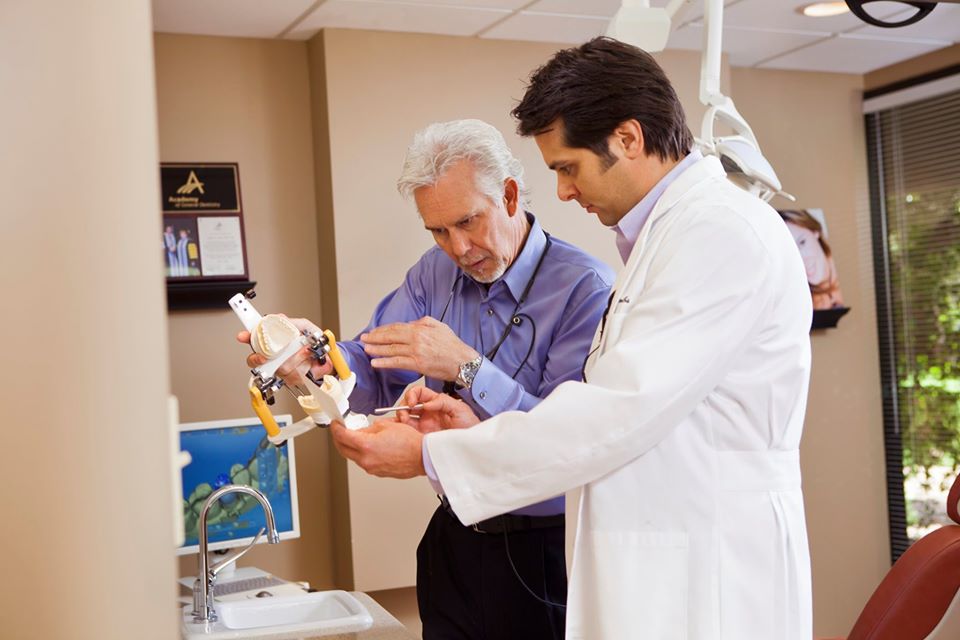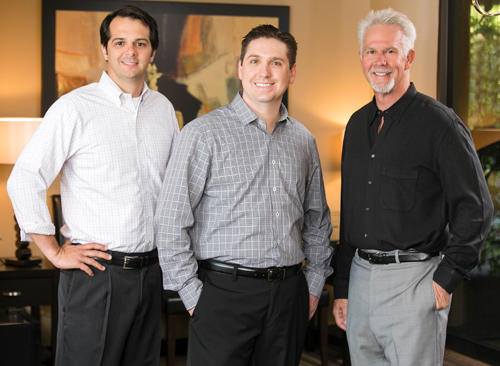Dr. Jonathan Coombs, DMD :
Doctor Coombs received his dental degree from the University of Louisville in 2000. In an effort to stay knowledgeable about the latest technologies and developments, Dr. Coombs has participated in hundreds of hours of continuing education earning the “Fellowship” status with the Academy of General Dentistry in 2009. An honor only 3% of dentist’s obtain.
Dr Coombs is also an active member in the following organizations:
- American Academy of Cosmetic Dentistry
- American Academy of Implant Dentistry
- American Academy of General Dentistry
- American Dental Association
- Central Arizona Dental Society
- Scottsdale/ Paradise Valley Study Club
- Give Back a Smile – for victims of domestic violence
- Christina Smile – care for Boys & Girls Club Kids
- Certified in Cerec – one visit restoration
- Certified Invisalign® Dentist
- Certified in advanced tooth whitening techniques.
Dental Implant Solutions:

Patients with missing teeth can replace them with a permanent alternative to traditional dentures that looks and feels like natural teeth. Offered by our Scottsdale dentists, dental implants not only help with chewing and speaking, but they are also custom-designed to fit comfortably in your mouth without slipping and other issues often caused by dentures. Plus, they become permanent fixtures of your mouth, and require no regular maintenance outside of your normal dental routine.
Our dentists utilize computer guided surgery and the innovative Cone Beam X-Ray technology, a digital mapping system that allows us to place dental implants with the most precise and accurate results possible. This precision is what can lead to results that look and feel so much like your natural teeth that it may be tough to tell the difference! Known as durable and strong restorative dental options, dental implants are one of the most successful functional and aesthetic dentistry procedures in use today.
Advantages of Implant Dentistry:
Dental implants are stronger and more durable than their restorative counterparts bridges and dentures. Implants offer a permanent solution to tooth loss. Additionally, implants may be used in conjunction with other restorative procedures for maximum effectiveness. For example, a single implant can serve to support a crown replacing a single missing tooth. Implants can also be used to support a dental bridge for the replacement of multiple missing teeth, and can be used with dentures (known as implant dentures) to increase stability and reduce gum tissue irritation.
While dental implants are a great solution for many patients, implants may not be the best solution for all patients. Our doctors will evaluate your individual situation and, if dental implants are not an option, develop a plan for an alternative solution.
Planning for Implants – Cone Beam X-Ray Technology
CT scans coupled with state of the art 3D software represents a tremendous leap forward in Dental Implant treatment planning. Prior to this combination, implants had to be planned with a 2-dimensional x-ray, leaving out the most important factors in both the predictability (bone density and bone width) and safety (3D relationship of the implants and nerves).
Now, with the exciting Cone Beam technology, a quick 20 second scan is processed in our office to recreate your true 3D anatomy, allowing us to do “virtual surgery” on your jaw, placing the correct size implant into the ideal location for you.
With older, less precise imaging modalities, it is not uncommon to have unexpected charges due to bone grafts or sinus grafts, or poor esthetic outcomes due to less than ideal placement.
What this new technology means to you is quick insertion of implants into the precise position with no “guesswork” during your treatment. Prior to your insertion procedure, you will be shown your case, and see exactly what will be placed and where. There will be no surprises!
The Dental Implant Procedure :
Today’s dental implants are virtually indistinguishable from other teeth. This appearance is aided in part by the structural and functional connection between the dental implant and the living bone. Implants are typically placed in a single sitting but require a period of osseointegration. Osseointegration is the process by which direct anchorage of a dental implant root and the bone of the jaw occurs. Osseointegrated implants are the most commonly used and successful type of dental implant. An osseointegrated implant takes anywhere from three to six months to anchor and heal, at which point our dentist can complete the procedure with the placement of a crown. Once the implant has anchored with the jawbone, an artificial prosthesis may be attached and the process is done. If osseointegration does not occur, the implant will fail.
Success Rates of Dental Implants :
Dental implants are among the most successful procedures in dentistry. There is no guarantee that an implant procedure will be successful, but studies have shown a five-year success rate of 95% for lower jaw implants and 90% for upper jaw implants. The success rate for upper jaw implants is slightly lower because the upper jaw (especially the posterior section) is less dense than the lower jaw, making successful implantation and osseointegration potentially more difficult to achieve. Lower posterior implantation has the highest success rate for all dental implants.
Our dentists will evaluate your needs during an initial consultation and talk with you about your options. For most patients, dental implant procedures have extraordinary success rates and significantly improve form and function of the teeth with permanent results.
Will my smile look fake after dental veneers or tooth whitening?
The experience of most people is that they recollect seeing people in person or on TV who have had all their teeth “fixed” to improve their appearance. This is usually back in the 1980s and earlier. Before the 1990s most cosmetic dental work for the front teeth involved using porcelain-metal crowns or caps. These created the appearance of flat, opaque, refrigerator-white fake or denture type teeth. Not only that, many times there were dark lines at the gum line [metal margins], and the gums looked red. Since the early 1990s, we have had technology that allows us to restore front teeth with metal-free ceramic dental veneers. There are no dark lines at the roots and the Veneers are translucent like natural teeth. Also, dental veneers do not irritate the gums, so they do not turn red. In almost all cases, this kind of dental work is undetectable.
How long will dental veneers for my front teeth last?
Once your teeth are reinforced with all-ceramic dental veneers, they now are very similar in wear resistance to natural teeth. Teeth tend to get worn down most at night when we are asleep. At this time we may tend to clench or grind our teeth. In general, food does not wear down our teeth. So, for people who may clench or grind at night, the answer to protecting dental veneers is the same as protecting natural teeth; wear a Night-Guard. Another aspect to this question concerns food types we ingest. As with natural teeth, we need to greatly reduce our intake of refined carbohydrates or sugars. This is especially true in terms of sugar in coffee or tea, soft drinks, gum and hard candy. We can additionally supplement with topical prescription strength fluoride gel to help reduce the incidence of new decay. It is totally realistic to expect natural teeth and those with dental veneers to last for years or even decades.
I would like to remove all the metal in my back teeth, but I don’t want my teeth cut down for caps or crowns.
When we remove all the metal in back teeth we remove the metal, all the underlying decay and evident fractures. All healthy natural tooth structure is left intact. It is not cut out. We take an impression of the defects and our laboratory makes ceramic replacements. These are then fused to the remaining natural tooth structure with adhesives. These teeth are now as strong as natural teeth (sometimes stronger) and were restored in the most conservative manner.
Why can’t I just wait until my teeth break or hurt, and then I have them fixed?
Yes, you could. And many people do this. But, once teeth begin to fail, or have fractured, many times the subsequent dental work is more extensive and expensive than if these same teeth were restored and reinforced earlier. In restoring these teeth earlier, we can avoid future root canal therapy, extraction, surgery, and bridges. The savings in money, time, and aggravation can be enormous.
What’s the difference between a regular cap or crown, and these metal-free restorations?
The difference is like night and day. The technologies are completely different. The method of their fabrication is completely different. First of all, traditional metal or porcelain-metal caps or crowns have all-metal undersides. This technology began in the early 1900s. Cements have to be used to fill the space between the metal and the tooth. The porcelain is placed over the metal to hide the dark metal. This is very difficult to do well, and many porcelain-metal crowns still look fake no matter how well they are made. And metal or gold crowns look like gold crowns. The metal free restorations are usually prepared as inlays, onlays, and sometimes as crowns when needed. Inlays and onlays are much more conservative. Secondly, the metal-free components are made of all-ceramic, composite polymers, or fiber reinforced polymer. These are then fused, or bonded to the natural part of the teeth with resin cements that polymerize and seal the space between the restoration and the tooth. This seal is better than the seal between metal and teeth with traditional cements. The subsequent result is teeth that look like natural translucent teeth. Very much like your own.
How can I make my smile look its absolute best?
If your teeth already look balanced and symmetrical, but are too yellow, brown, gray, or stained, then the best solution is teeth whitening. In two to four weeks teeth whitening can completely change your look. On the other hand, if your front teeth are a little too short, spaced unevenly, chipped, cracked, stained, filled with all kinds of fillings, or your teeth genetic make-up was just not as good as the rest of your genetic make-up, then using dental veneers will definitely give you the best end result. If there are just isolated problems, but the rest of your teeth look great, then direct resin composite can easily correct this. Sometimes, we will bleach all the teeth, and then use dental veneers or composite resin to improve localized areas, and match the new, whiter shade. There are an unlimited number of combinations of services to help attain a spectacular look, and dental veneers and tooth whitening can give our Arizona patients a complete smile makeover.
How long does it take to improve my smile?
In more difficult cases, using all ceramic dental veneers usually takes three to four weeks (including laboratory time) from start to finish. This includes two appointments; the first appointment for dental veneers will be several hours long, and the second appointment will be half as long. When using direct resin composite, we can finish all work in one visit.
How do I take care of these metal-free teeth, so they will last forever?
You can get many, many years of mileage out of your newly restored teeth by wearing a Night Guard at night, eliminating refined sugar in your diet, using a prescription fluoride gel daily, and seeing a hygienist on a regular basis. If you do so, it is possible you will not have to see a dentist for a very long time.
How can I get tooth whitening done for the least cost?
Tooth whitening can be accomplished in the office in one hour or at home in two to four weeks. The best results are achieved using tooth whitening systems that allow you to bleach at home. This way you have full control over the outcome.
OK, I’m ready to improve my smile and appearance, but how am I going to be sure that I will like what I get?
That’s simple. We have been enhancing smiles for many years. We have found that the more control we can give up to our clients, the better the expected result. Initially, we use a series of before/after photos to narrow down the variables concerning an individual’s case. We then use digital imaging and software to produce an approximation of what the final result may look like, whether you opt for tooth whitening, dental veneers, or another treatment. You will see a before photo and an after photo before any work is begun. Finally, we can do a cosmetic mock-up directly on your teeth. This takes an hour or so, but then you can see exactly how you will look with your new smile. It is here where we can make any needed changes, so that you are completely satisfied. Once you give the OK, then we will make replicas of this cosmetic mock-up so our laboratory will know exactly what you expect.




